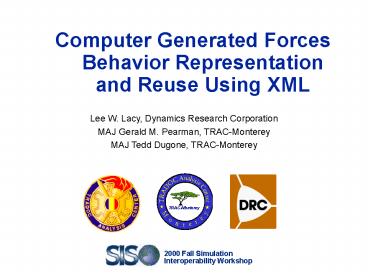Computer Generated Forces Behavior Representation and Reuse Using XML
1 / 19
Title:
Computer Generated Forces Behavior Representation and Reuse Using XML
Description:
Equipment Characteristics and Performance Data (e.g., AMSO SIMTECH initiative) ... Used to present XML data on a variety of devices/output media ... –
Number of Views:51
Avg rating:3.0/5.0
Title: Computer Generated Forces Behavior Representation and Reuse Using XML
1
Computer Generated Forces Behavior
Representationand Reuse Using XML
Lee W. Lacy, Dynamics Research Corporation MAJ
Gerald M. Pearman, TRAC-Monterey MAJ Tedd Dugone,
TRAC-Monterey
2
CGF Behaviors
- Computer Generated Forces (CGF) systems simulate
units and platforms - CGF systems operate at a variety of fidelity and
resolution levels - Behaviors historically hard coded
- Newer systems represent behaviors in data
- Considerable resources required to develop CGF
systems and their associated behaviors
3
CGF Behaviors Vision
Improve the timeliness, quality, and
cost-effectiveness of developing Computer
Generated Forces by standardizing the interchange
of behavior data.
Standardized Interchange Supports Reuse
4
Current CGF Systems
- Asynchronous Augment Finite State Machines
(translated into C code)
- Behavioral Description Frames
- Fundamental Behaviors (C code)
- Ada Finite State Machines
Todays CGF systems are built in a stove-piped
manner
5
eXtensible Markup Language (XML)
- World Wide Web Consortium (W3C) Standard
- Evolved from another metalanguage SGML
- Uses tags to markup Unicode (text) data
- Commercial support for standard reduces
requirement for custom code - Individual domains develop languages with
specific tag sets
6
MS Community use of XML
- HLA Data Interchange Formats (DIFs)
- JSIMS Common Component Workstation Battlespace
Schema - Equipment Characteristics and Performance Data
(e.g., AMSO SIMTECH initiative) - High Level Architecture (HLA) Dynamic Scenario
Builder (DSB)
XML integrated in newest DoD simulations and
architectures
7
Perfect World Behavior Sharing
System 1
System 2
Behaviors Represented in Common Language Using
XML
System 3
System 4
8
CCTT Instance
Representation Class
ModSAF Instance
WARSIM Instance
Primarily Platform-level Constructive Environment
Platform Group Constructive Environment
Platform-level Virtual Environment
Real World
Doctrine (primarily ARTEPs)
Authoritative Data Sources
Doctrine, SMEs
Doctrine
Knowledge Acquisition / Knowledge Engineering
Documents
Combat Instruction Sets and Default Parameters
Files
Conceptual Model
Unit, Mission, Task Models
Operational Domain Outlines
Behavior Scoping Documents
SRS, SDD
SRS, SDD
Behavior Representation Implementation
Behavior Definition Frames, Fundamental Behaviors
(code), Predicate Semantics, and Behavior Data
Sets
AAFSM and Reader Files
Software
Unit Software (C code) and Unit Behavior
Parameter Tables
C Code
Ada Finite State Machines (code)
9
Integrating Legacy System Behaviors
WARSIM BDFs
Conversions Required to Satisfy Native Formats
Behaviors Represented Using XML
CCTT CISs
Legacy Systems Require Translation to Global
Standard
10
CGF Behavioral Representation Logical Data Model
Components
11
Namespace use for Subdomains
Leveraging existing XML namespaces
12
Monster DTD
- Impossible to create a single CGF language
supporting all possible implementations - Maintenance nightmare to support large number of
data elements - Each CGF system needs an XML language
- Sharing CGF behavior representations is really an
integration problem
13
Stovepipes using XML
Legacy systems require translation software to
import/export XML (solves syntactic problem)
Legacy System
Future systems may import/export XML natively
Future
14
eXtensible Style Language
- Originally focused on providing the format
separated out from the content described in XML - Used to present XML data on a variety of
devices/output media - Extension into XSL Transformations (XSLT) for
transforming data between XML files with
different structures - Requires mapping
15
Sharing XML Files
16
Simplify XSLT Mapping
- Source and Destination both XML files describing
CGF behaviors (different structures describing
different CGF systems) - Divide into common sections (Metadata, KR
constructs, declarative, procedural, strategic) - Use common namespaces (e.g., vCard, Dublin Core)
- Employ XSLT technology to declare mappings
17
XSLT Mapping Example
ltOneSAFComposableBehaviorgt ltMetadatagt ltDCAuthorgt
ltLastgtSmithlt/Lastgt ltFirstgtRogerlt/Rogergt lt/DCAut
horgt ltDCDategtJuly 4, 2002lt/DCDategt ltCompositionR
ulegt o o o
ltWARSIMBDFgt ltMetadatagt ltDCAuthorgtCasey
Younglt/DCAuthorgt ltDCDategt07/10/00lt/DCDategt ltTea
mgtField Artillerylt/Teamgt o o o
18
Conclusions
- Wide divergence exists in legacy approaches /
representations - Global / Common language that satisfies all past
and future systems is unrealistic - Challenge is two parts syntactic and semantic
- Use XML representations to solve syntactic
problem - Use XSLT to support mappings for semantic
solution - Leverage Existing Namespaces to simplify mappings
19
Questions?
Lee Lacy (407) 380-1200 x104 LLacy_at_DRC.com






























